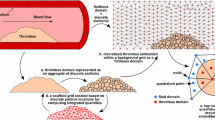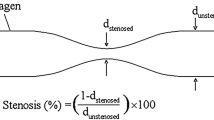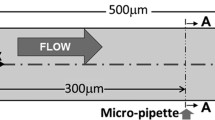Abstract
A pathologically formed blood clot or thrombus is central to major cardiovascular diseases like heart attack and stroke. Detailed quantitative evaluation of flow and flow-mediated transport processes in the thrombus neighborhood within large artery hemodynamics is crucial for understanding disease progression and assessing treatment efficacy. This, however, remains a challenging task owing to the complexity of pulsatile viscous flow interactions with arbitrary shape and heterogeneous microstructure of realistic thrombi. Here, we address this challenge by conducting a systematic parametric simulation-based study on characterizing unsteady hemodynamics and flow-mediated transport in the neighborhood of an arterial thrombus. We use a hybrid particle—continuum-based finite element approach to handle arbitrary thrombus shape and microstructural variations. Results from a cohort of 50 different unsteady flow scenarios are presented, including unsteady vortical structures, pressure gradient across the thrombus boundary, finite time Lyapunov exponents, and dynamic coherent structures that organize advective transport. We clearly illustrate the combined influence of three key parameters—thrombus shape, microstructure, and extent of wall disease—in terms of: (a) determining hemodynamic features in the thrombus neighborhood and (b) governing the balance between advection, permeation, and diffusion to regulate transport processes in the thrombus neighborhood.










Similar content being viewed by others
References
Alnæs M, Blechta J, Hake J, Johansson A, Kehlet B, Logg A, Richardson C, Ring J, Rognes M, Wells G (2015) The fenics project version 1.5. Archiv Numer Softw 3(100):9–23
Bajd F, Serša I (2013) Mathematical modeling of blood clot fragmentation during flow-mediated thrombolysis. Biophys J 104(5):1181–1190
Bark D, Para A, Ku D (2012) Correlation of thrombosis growth rate to pathological wall shear rate during platelet accumulation. Biotechnol Bioeng 109(10):2642–2650
Berndt M, Friedrich B, Maegerlein C, Moench S, Hedderich D, Lehm M, Zimmer C, Straeter A, Poppert H, Wunderlich S et al (2018) Thrombus permeability in admission computed tomographic imaging indicates stroke pathogenesis based on thrombus histology. Stroke 49(11):2674–2682
Brass LF, Diamond SL (2016) Transport physics and biorheology in the setting of hemostasis and thrombosis. J Thromb Haemost 14(5):906–917
Breugem W, Boersma B, Uittenbogaard R (2005) The laminar boundary layer over a permeable wall. Transp Porous Media 59(3):267–300
Brooks A, Hughes T (1982) Streamline upwind/Petrov-Galerkin formulations for convection dominated flows with particular emphasis on the incompressible Navier-Stokes equations. Comput Methods Applied Mech Eng 32(1–3):199–259
Cabral B and Leedom L (1993). Imaging vector fields using line integral convolution. In: Proceedings of the 20th annual conference on Computer graphics and interactive techniques pp 263–270. ACM, 1993
Calaminus S, Auger J, McCarty O, Wakelam M, Machesky L, Watson S (2007) Myosiniia contractility is required for maintenance of platelet structure during spreading on collagen and contributes to thrombus stability. J Thromb Haemost 5(10):2136–2145
Chen J,Kim OV, Litvinov RI, Weisel JW, Alber MS and Chen DZ (2014) An automated approach for fibrin network segmentation and structure identification in 3d confocal microscopy images. In: 2014 IEEE 27th International Symposium on Computer-Based Medical Systems, pp 173–178. IEEE
Cines D, Lebedeva T, Nagaswami C, Hayes V, Massefski W, Litvinov R, Rauova L, Lowery T, Weisel J (2014) Clot contraction: compression of erythrocytes into tightly packed polyhedra and redistribution of platelets and fibrin. Blood 123(10):1596–1603
Colace T, Muthard R, Diamond S (2012) Thrombus growth and embolism on tissue factor-bearing collagen surfaces under flow. Arterioscler Thromb Vasc Biol 32(6):1466–1476
Diamond SL (1999) Engineering design of optimal strategies for blood clot dissolution. Ann Rev Biomed Eng 1(1):427–461
Flamm M, Diamond S (2012) Multiscale systems biology and physics of thrombosis under flow. Ann Biomed Eng 40(11):2355–2364
Fogelson AL, Neeves KB (2015) Fluid mechanics of blood clot formation. Ann Rev Fluid Mech 47:377–403
Franca L, Frey S, Hughes T (1992) Stabilized finite element methods: I application to the advective-diffusive model. Comput Methods Appl Mech Eng 95(2):253–276
Gogia S, Neelamegham S (2015) Role of fluid shear stress in regulating vwf structure, function and related blood disorders. Biorheology 52(5–6):319–335
Gorog DA, Fayad ZA, Fuster V (2017) Arterial thrombus stability: does it matter and can we detect it? J Am Coll Cardiol 70(16):2036–2047
Haller G (2015) Lagrangian coherent structures. Ann Rev Fluid Mech 47:137–162
Hathcock J (2006) Flow effects on coagulation and thrombosis. Arterioscler Thromb Vasc Biol 26(8):1729–1737
Jaffer I, Fredenburgh J, Hirsh J, Weitz J (2015) Medical device-induced thrombosis: what causes it and how can we prevent it? J Thromb Haemost 13(S1):S72–S81
Kenwright DN, Lane DA (1996) Interactive time-dependent particle tracing using tetrahedral decomposition. IEEE Trans Vis Comput Graph 2(2):120–129
Kim H, Vignon-Clementel I, Figueroa C, LaDisa J, Jansen K, Feinstein J, Taylor C (2009) On coupling a lumped parameter heart model and a three-dimensional finite element aorta model. Ann Biomed Eng 37(11):2153–2169
Kim OV, Xu Z, Rosen ED, Alber MS (2013) Fibrin networks regulate protein transport during thrombus development. PLoS Comput Biol 9(6):e1003095
Lam W, Chaudhuri O, Crow A, Webster K, Li T, Kita A, Huang J, Fletcher D et al (2011) Mechanics and contraction dynamics of single platelets and implications for clot stiffening. Nat Mater 10(1):61–66
Lee S, Antiga L, Spence J, Steinman D (2008) Geometry of the carotid bifurcation predicts its exposure to disturbed flow. Stroke 39(8):2341–2347
Leiderman K, Fogelson A (2011) Grow with the flow: a spatial-temporal model of platelet deposition and blood coagulation under flow. Math Med Biol 28(1):47–84
Leiderman K, Fogelson A (2014) An overview of mathematical modeling of thrombus formation under flow. Thromb Res 133:S12–S14
Liu D and Yu J (2009) Otsu method and k-means. In: 2009 Ninth International Conference on Hybrid Intelligent Systems 1: 344–349. IEEE
Mirramezani M, Herbig B, Stalker T, Nettey L, Cooper M, Weisel J, Diamond S, Sinno T, Brass L, Shadden S et al (2018) Platelet packing density is an independent regulator of the hemostatic response to injury. J Thromb Haemost 16(5):973–983
Mukherjee D, Shadden SC (2018) Modeling blood flow around a thrombus using a hybrid particle-continuum approach. Biomech Modeling Mechanobiol 17(3):645–663
Muthard RW, Diamond SL (2012) Blood clots are rapidly assembled hemodynamic sensors: flow arrest triggers intraluminal thrombus contraction. Arterioscler Thromb Vasc Biol 32(12):2938–2945
Nesbitt W, Westein E, Tovar-Lopez F, Tolouei E, Mitchell A, Fu J, Carberry J, Fouras A, Jackson S (2009) A shear gradient-dependent platelet aggregation mechanism drives thrombus formation. Nat Med 15(6):665–673
Ono A, Westein E, Hsiao S, Nesbitt W, Hamilton J, Schoenwaelder S, Jackson S (2008) Identification of a fibrin-independent platelet contractile mechanism regulating primary hemostasis and thrombus growth. Blood 112(1):90–99
Otsu N (1979) A threshold selection method from gray-level histograms. IEEE Trans Syst Man Cybern 9(1):62–66
Piebalgs A, Gu B, Roi D, Lobotesis K, Thom S, Xu XY (2018) Computational simulations of thrombolytic therapy in acute ischaemic stroke. Sci Rep 8(1):1–13
Pivkin I, Richardson P, Karniadakis G (2006) Blood flow velocity effects and role of activation delay time on growth and form of platelet thrombi. Proc Nat Acad Sci 103(46):17164–17169
Rha J-H, Saver JL (2007) The impact of recanalization on ischemic stroke outcome: a meta-analysis. Stroke 38(3):967–973
Schlichting H, Gersten K (2016) Boundary-layer theory. Springer, Berlin
Shadden S (2011) Lagrangian coherent structures. In: Grigoriev R (ed) Transport and mixing in laminar flows: from microfluidics to oceanic currents, chapter 3. Wiley, Hoboken, pp 59–89
Shadden SC, Hendabadi S (2013) Potential fluid mechanic pathways of platelet activation. Biomech Modeling Mechanobiol 12(3):467–474
Shadden SC, Taylor CA (2008) Characterization of coherent structures in the cardiovascular system. Ann Biomed Eng 36(7):1152–1162
Shadden SC, Lekien F, Marsden JE (2005) Definition and properties of Lagrangian coherent structures from finite-time Lyapunov exponents in two-dimensional aperiodic flows. Phys D Nonlinear Phenom 212(3–4):271–304
Stalker TJ, Welsh JD, Tomaiuolo M, Wu J, Colace TV, Diamond SL, Brass LF (2014) A systems approach to hemostasis: 3 thrombus consolidation regulates intrathrombus solute transport and local thrombin activity. Blood J Am Soc Hematol 124(11):1824–1831
Sweet CR, Chatterjee S, Xu Z, Bisordi K, Rosen ED, Alber M (2011) Modelling platelet-blood flow interaction using the subcellular element Langevin method. J R Soc Interface 8(65):1760–1771
Tilton N, Cortelezzi L (2015) Stability of boundary layers over porous walls with suction. AIAA J 53(10):2856–2868
Tomaiuolo M, Stalker T, Welsh J, Diamond S, Sinno T, Brass L (2014) A systems approach to hemostasis: 2. computational analysis of molecular transport in the thrombus microenvironment. Blood 124(11):1816–1823
Tomaiuolo M, Brass LF, Stalker TJ (2017) Regulation of platelet activation and coagulation and its role in vascular injury and arterial thrombosis. Interv Cardiol Clin 6(1):1
Van der Walt S, Schönberger JL, Nunez-Iglesias J, Boulogne F, Warner JD, Yager N, Gouillart E, Yu T (2014) Scikit-image: image processing in python. Peer J 2:e453
Vignon-Clementel I, Figueroa C, Jansen K, Taylor C (2006) Outflow boundary conditions for three-dimensional finite element modeling of blood flow and pressure in arteries. Comput Methods Appl Mech Eng 195(29):3776–3796
Virani SS, Alonso A, Benjamin EJ, Bittencourt MS, Callaway CW, Carson AP, Chamberlain AM, Chang AR, Cheng S, Delling FN, Djousse L, Elkind MSV, Ferguson JF, Fornage M, Khan SS, Kissela BM, Knutson KL, Kwan TW, Lackland DT, Lewis TT, Lichtman JH, Longenecker CT, Loop MS, Lutsey PL, Martin SS, Matsushita K, Moran AE, Mussolino ME, Perak AM, Rosamond WD, Roth GA, Sampson UKA, Satou GM, Schroeder EB, Shah SH, Shay CM, Spartano NL, Stokes A, Tirschwell DL, VanWagner LB, Tsao CW (2020) Heart disease and stroke statistics—2020 update: a report from the american heart association. Circulation 141(9):e139–e596
Wardlaw JM, Murray V, Berge E, Del Zoppo G, Sandercock P, Lindley RL, Cohen G (2012) Recombinant tissue plasminogen activator for acute ischaemic stroke: an updated systematic review and meta-analysis. Lancet 379(9834):2364–2372
Weisel JW and Litvinov RI (2017) Fibrin formation, structure and properties. Fibrous proteins: structures and mechanisms, pp 405–456. Springer
Welsh JD, Stalker TJ, Voronov R, Muthard RW, Tomaiuolo M, Diamond SL, Brass LF (2014) A systems approach to hemostasis: 1. the interdependence of thrombus architecture and agonist movements in the gaps between platelets. Blood J Am Soc Hematol 124(11):1808–1815
Wendelboe AM, Raskob GE (2016) Global burden of thrombosis: epidemiologic aspects. Circ Res 118(9):1340–1347
Wolberg AS (2007) Thrombin generation and fibrin clot structure. Blood Rev 21(3):131–142
Wootton DM, Ku DN (1999) Fluid mechanics of vascular systems, diseases, and thrombosis. Ann Rev Biomed Eng 1(1):299–329
Wufsus A, Macera N, Neeves K (2013) The hydraulic permeability of blood clots as a function of fibrin and platelet density. Biophys J 104(8):1812–1823
Xu Z, Chen N, Kamocka M, Rosen E, Alber M (2008) A multiscale model of thrombus development. J R Soc Interface 5(24):705–722
Xu Z, Chen N, Shadden SC, Marsden JE, Kamocka MM, Rosen ED, Alber M (2009) Study of blood flow impact on growth of thrombi using a multiscale model. Soft Matter 5(4):769–779
Yazdani A, Li H, Humphrey JD, Karniadakis GE (2017) A general shear-dependent model for thrombus formation. PLoS Comput Biol 13(1):e1005291
Zhang C, Neelamegham S (2017) Application of microfluidic devices in studies of thrombosis and hemostasis. Platelets 28(5):434–440
Zheng X, Yazdani A, Li H, Humphrey JD, Karniadakis GE (2020) A three-dimensional phase-field model for multiscale modeling of thrombus biomechanics in blood vessels. PLoS Comput Biol 16(4):e1007709
Zubairova LD, Nabiullina RM, Nagaswami C, Zuev YF, Mustafin IG, Litvinov RI, Weisel JW (2015) Circulating microparticles alter formation, structure and properties of fibrin clots. Sci Rep 5(1):1–13
Acknowledgements
This work was partly supported by the American Heart Association (Award: 16POST27500023) and the Burroughs Wellcome Fund (Award: 1016360). This work utilized resources from the University of Colorado Boulder Research Computing Group, which is supported by the National Science Foundation (Awards ACI-1532235 and ACI-1532236), the University of Colorado Boulder, and Colorado State University. The Authors also gratefully acknowledge guidance, support, and the many valuable discussions with Prof. Scott L. Diamond, Department of Chemical and Biomolecular Engineering, University of Pennsylvania. These fruitful discussions strongly benefited the study design and interpretation of results. CT performed the flow simulations, data analysis, and contributed toward manuscript content. ZI performed Lagrangian computations and data analysis. DM developed the numerical methods and computer libraries, designed the study, and wrote the manuscript. SCS contributed key inputs to finalize study design, and simulation data analysis and interpretation. All authors reviewed the manuscript and agreed to the final version.
Author information
Authors and Affiliations
Corresponding author
Ethics declarations
Conflict of interest
The authors declare no conflicts of interest pertaining to the research presented here.
Additional information
Publisher's Note
Springer Nature remains neutral with regard to jurisdictional claims in published maps and institutional affiliations.
Supplementary information
Supplementary material 1 (mp4 4524 KB)
Supplementary material 2 (mp4 10375 KB)
Rights and permissions
About this article
Cite this article
Teeraratkul, C., Irwin, Z., Shadden, S.C. et al. Computational investigation of blood flow and flow-mediated transport in arterial thrombus neighborhood. Biomech Model Mechanobiol 20, 701–715 (2021). https://doi.org/10.1007/s10237-020-01411-7
Received:
Accepted:
Published:
Issue Date:
DOI: https://doi.org/10.1007/s10237-020-01411-7




